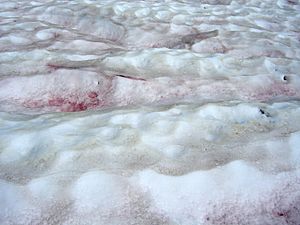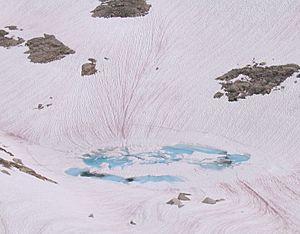Ice algae facts for kids

This is a close-up photo using an electron microscope, with colors added artificially.
Ice algae and snow algae are tiny living things, like plants, that grow on snow and ice that lasts a long time, such as glaciers. When there's liquid water between the snow and ice crystals, these algae can make the surface look green, yellow, or red during summer.
Some types of red algae have a special red color inside them. This color protects them from too much sunlight and UV rays. Without this protection, the strong sun could harm the algae's ability to make food or even damage their DNA.
There are also ice algae communities that live on sea ice. These algae, mostly a type called diatoms, are very important in cold places like Antarctica. They provide food for small sea creatures called krill. Krill scrape the algae off the bottom of the ice, which often looks brown because of the algae. These tiny algae can be found between ice crystals, attached to them, or in the water and salty channels within the ice.
Contents
What is Watermelon Snow?
Chlamydomonas nivalis is a type of green microalga that causes something cool called Watermelon snow. This snow looks reddish or pink and can even smell a bit like fresh watermelon!
You can often find Watermelon snow in the summer in high mountains and cold coastal areas, like the Sierra Nevada mountains in California. In these places, it's cold all year, so snow from winter storms stays on the ground. If you step on snow with these algae, your footprints will look red!
How Chlamydomonas nivalis Works
The red color of Chlamydomonas nivalis comes from a bright red pigment called Astaxanthin. This pigment protects the algae's green parts (where it makes food) and its main control center (the cell nucleus) from strong sunlight and UV rays.
Both the green and red pigments in the algae soak up light and heat. This helps the snow around the algae melt, giving them the liquid water they need to live. Sometimes, these algae can grow very deep, up to 25 centimeters (10 inches) into the snow. A single teaspoon of melted snow can hold over a million of these tiny cells, which are only about 20 to 30 micrometers wide!
The algae often gather in 'sun cups,' which are small dips in the snow. Because the red pigment absorbs heat, these sun cups get deeper. This can make glaciers and snowbanks melt faster.
Life Cycle of Snow Algae
During the winter, when the snow is white and covers them, the algae go into a resting state, like sleeping. In spring, when there's more light, nutrients, and melting snow, they wake up and start to grow.
When they wake up, the resting cells release smaller, green cells that have tiny tails called flagella. These tails help them swim towards the surface of the snow. Once they get close to the surface, they might lose their tails and form new resting cells. Or, they might join together in pairs to create new cells.
Some special creatures love to eat C. nivalis. These include tiny animals like protozoans (such as ciliates), rotifers, nematodes, ice worms, and springtails.
History of Watermelon Snow
People have known about watermelon snow for a very long time. The ancient Greek thinker Aristotle even wrote about it! For thousands of years, mountain climbers, explorers, and naturalists have been puzzled by this strange red snow.
One famous sighting happened in May 1818. Four ships from England were exploring the Arctic to find a way through to North America. Even though bad weather made them turn back, their trip helped science a lot. Captain John Ross saw bright red snow that looked like streaks of blood on the white cliffs near Cape York in Greenland. His team collected samples and brought them back to England.
A newspaper called The Times wrote about this discovery on December 4, 1818:
Captain Sir John Ross has brought from Baffin's Bay a quantity of red snow, or rather snow-water, which has been studied in this country, to find out what makes it colored. It's hard to believe, but we have no reason to doubt the facts. Sir John Ross did not see red snow fall; but he saw large areas covered with it. The color of the snow fields was not the same everywhere; instead, there were patches or streaks that were more or less red, and of different shades. The liquid, or melted snow, is such a dark red that it looks like red port wine. It is said that the liquid leaves a sediment; and it's not known if that sediment is from an animal or a plant. Some think the color comes from the soil where the snow falls: in this case, no red snow could have been seen on the ice.
When Captain Ross published his story about the journey in 1818, it included a section about plants written by Robert Brown. In this section, Brown suggested that the red snow was caused by a type of alga.
Images for kids
See also
 In Spanish: Algas del hielo para niños
In Spanish: Algas del hielo para niños





